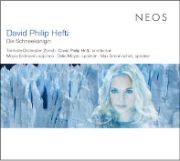Icy, eerie moods
David Philip Hefti has created a "Snow Queen" with shimmering quarter tones and serial techniques that should appeal to adults and children.

It was a prestigious anniversary commission awarded by the Tonhalle Orchestra Zurich in 2018 to mark its 150th birthday. And it was intended to benefit young audiences, i.e. children and teenagers. David Philip Hefti accepted, even though he had never composed for young people before. He wrote his second piece of music theater, The Snow Queen based on the fairy tale of the same name by Hans Christian Andersen. The live recording of the semi-staged premiere has now been released on CD.
Hefti says that as a young father, he came into contact with several musical productions for children. He has experienced good, but also very non-committal performances. "And I think that adults are often neglected in family concerts." So why not compose a fairy tale for adults that children can also understand? Add to that the fact that The Snow Queen has not only been released recently as an animated film by Disney, but in Germany and Denmark several composers have adapted the material for musical theater.
However, the fairy tale by Danish author Andersen has been accused of being too long and too complex for children and lacking "naivety and authenticity". It is the story of two children, Gerda and Kay, who fall into the clutches of the Snow Queen. Kay becomes cold and unfeeling, Gerda misses him and searches for him. The Snow Queen appears to her in various guises to stop her. The warm tears that Gerda cries when she sees Kay again also thaw his feelings.
The author Andreas Schäfer has created a libretto that is simple and easy to understand, but the "abstract" aspect of Andersen's original remains. Does a child understand when "poetry" conquers the Snow Queen? It is Hefti's music that makes the fairy tale come alive. He knows how to capture the atmosphere of the icy and eerie with shimmering quarter tones and serial techniques.
The musical theater has only one singing part, the others are speaking roles. Soprano Mojca Erdmann has to portray four different characters at once: in addition to the Snow Queen, she also appears as an old woman, a young man and a robber's bride. Erdmann sings this challenging role with impressive color changes, she masters the low register just as confidently as the virtuosic, soaring role of the Snow Queen. Yet for all the drama required, she remains true to her lyrical voice.
The two actors Delia Mayer and Max Simonischek also contribute greatly to the success of this production. They tell the story with great empathy, know how to alternate with relish between liveliness and desolation and give the two children sympathetic and authentic voices. Hefti's score is very precisely notated and demands great attention and musicality (it is available, as well as the piano reduction and the libretto, from Edition Kunzelmann). The Tonhalle Orchestra, conducted by the composer, is also able to convey the mysterious aura of this music in a multi-layered way in the recording.
David Philip Hefti: The Snow Queen. Libretto: Andreas Schäfer after Hans Christian Andersen. Mojca Erdmann, soprano; Delia Mayer, narrator; Max Simonischek, narrator; Tonhalle Orchestra Zurich; conducted by David Philip Hefti. Neos Music NEOS 12028








